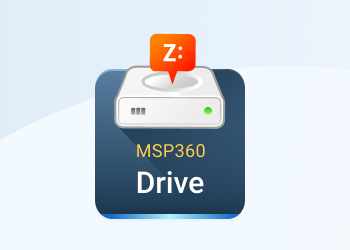MSP360 Drive receives another major update that brings the highly-requested multi-user mode for Office documents as well as various bug fixes and optimizations.
Multi-User Mode for Office Documents
MSP360 Drive 3.0 introduces the anticipated multi-user mode for Microsoft Office documents. Unlike in previous versions, MSP360 Drive 3.0 prevents two or more people from simultaneously editing the same Office document . With this new feature enabled, there is no risk that a second user accidentally overwrites modifications being made by the first, active user.
MSP360 Drive 3.0 automatically recognizes that an Office document is being modified and lets other parties view the document in read-only mode. Microsoft Office can also notify the read-only users when the file is available for editing.
This locking mechanism is achieved by creating a temporary marker file in the same directory that indicates that the file is being modified and can only be accessed in read-only mode. Once the user completes modifying the Office document, the marker file is removed, and the Office document becomes available for modifications by other parties.
Multi-user mode is enabled in the Mapped Drives - Edit - Edit Advanced Options dialog by selecting the Microsoft Office files lock control option.
Multi-user mode for Microsoft Office documents in MSP360 Drive 3.0 is only available only when cloud storage is added as a Network Mapped Drive (default mode).
Optimization for Windows Explorer
Another new feature is enhanced optimization for Windows Explorer. As you know, MSP360 Drive lists files located in the cloud and displays them as regular files in Windows Explorer. In addition to interacting with the cloud, MSP360 Drive also interacts with Windows Explorer. This integration means MSP360 Drive has to process Windows Explorer requests like checking if folders are empty, showing thumbnails, etc.
These requests are often time consuming and can slow down file listings in Windows Explorer. This issue is caused by Windows Explorer requesting access to cloud files like thumbs.db, desktop.ini, and autorun.inf. To help address these performance issues, MSP360 Drive 3.0 implements a mechanism to search for these files in cache instead of pulling them from the cloud. As a result, performance is considerably improved.
Optimization for Windows Explorer can be enabled in the Mapped Drives - Edit - Edit Advanced Options dialog by selecting the Optimize for Windows Explorer option.
Conclusion
MSP360 Drive is a handy tool that integrates cloud storage services into Windows Explorer and lets you interact with cloud files the way you would with local files. Release 3.0 brings notable improvements like multi-user mode for Office documents as well as enhanced optimization for Windows Explorer. Feel free to check out MSP360 Drive 3.0 and share your feedback in the comment section below.

